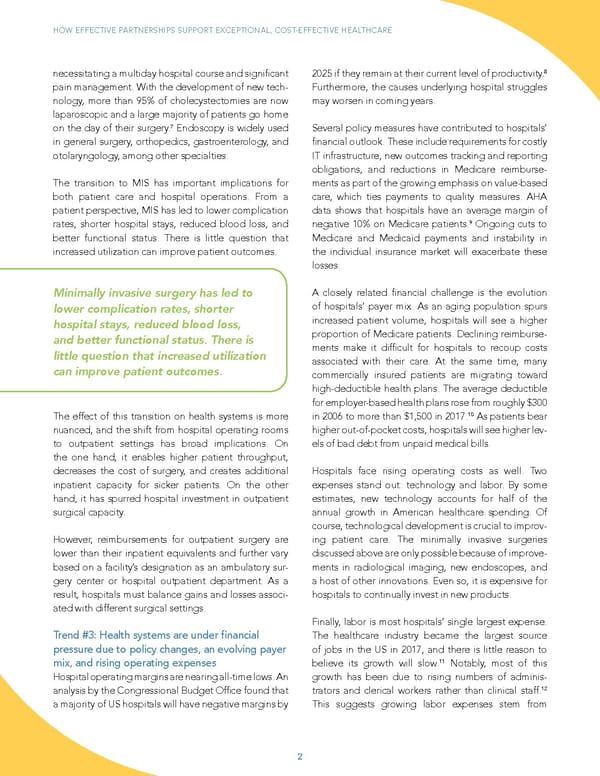HOW EFFECTIVE PARTNERSHIPS SUPPORT EXCEPTIONAL, COST-EFFECTIVE HEALTHCARE 8 necessitating a multiday hospital course and significant 2025 if they remain at their current level of productivity. pain management. With the development of new tech- Furthermore, the causes underlying hospital struggles nology, more than 95% of cholecystectomies are now may worsen in coming years. laparoscopic and a large majority of patients go home 7 on the day of their surgery. Endoscopy is widely used Several policy measures have contributed to hospitals’ in general surgery, orthopedics, gastroenterology, and financial outlook. These include requirements for costly otolaryngology, among other specialties. IT infrastructure, new outcomes tracking and reporting obligations, and reductions in Medicare reimburse- The transition to MIS has important implications for ments as part of the growing emphasis on value-based both patient care and hospital operations. From a care, which ties payments to quality measures. AHA patient perspective, MIS has led to lower complication data shows that hospitals have an average margin of 9 rates, shorter hospital stays, reduced blood loss, and negative 10% on Medicare patients. Ongoing cuts to better functional status. There is little question that Medicare and Medicaid payments and instability in increased utilization can improve patient outcomes. the individual insurance market will exacerbate these losses. Minimally invasive surgery has led to A closely related financial challenge is the evolution lower complication rates, shorter of hospitals’ payer mix. As an aging population spurs hospital stays, reduced blood loss, increased patient volume, hospitals will see a higher and better functional status. There is proportion of Medicare patients. Declining reimburse- little question that increased utilization ments make it difficult for hospitals to recoup costs associated with their care. At the same time, many can improve patient outcomes. commercially insured patients are migrating toward high-deductible health plans. The average deductible for employer-based health plans rose from roughly $300 The effect of this transition on health systems is more in 2006 to more than $1,500 in 2017.10 As patients bear nuanced, and the shift from hospital operating rooms higher out-of-pocket costs, hospitals will see higher lev- to outpatient settings has broad implications. On els of bad debt from unpaid medical bills. the one hand, it enables higher patient throughput, decreases the cost of surgery, and creates additional Hospitals face rising operating costs as well. Two inpatient capacity for sicker patients. On the other expenses stand out: technology and labor. By some hand, it has spurred hospital investment in outpatient estimates, new technology accounts for half of the surgical capacity. annual growth in American healthcare spending. Of course, technological development is crucial to improv- However, reimbursements for outpatient surgery are ing patient care. The minimally invasive surgeries lower than their inpatient equivalents and further vary discussed above are only possible because of improve- based on a facility’s designation as an ambulatory sur- ments in radiological imaging, new endoscopes, and gery center or hospital outpatient department. As a a host of other innovations. Even so, it is expensive for result, hospitals must balance gains and losses associ- hospitals to continually invest in new products. ated with different surgical settings. Finally, labor is most hospitals’ single largest expense. Trend #3: Health systems are under financial The healthcare industry became the largest source pressure due to policy changes, an evolving payer of jobs in the US in 2017, and there is little reason to mix, and rising operating expenses believe its growth will slow.11 Notably, most of this Hospital operating margins are nearing all-time lows. An growth has been due to rising numbers of adminis- analysis by the Congressional Budget Office found that trators and clerical workers rather than clinical staff.12 a majority of US hospitals will have negative margins by This suggests growing labor expenses stem from 2
 Surgical Solutions White Paper Page 3 Page 5
Surgical Solutions White Paper Page 3 Page 5